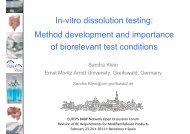2011 Anniversary Yearbook - EUFEPS today and history
2011 Anniversary Yearbook - EUFEPS today and history
2011 Anniversary Yearbook - EUFEPS today and history
You also want an ePaper? Increase the reach of your titles
YUMPU automatically turns print PDFs into web optimized ePapers that Google loves.
<strong>EUFEPS</strong> Newsletter, 1997, vol. 6, issue 3<br />
Biopharmaceutical<br />
Classification System (BCS)<br />
for Oral Immediate-release<br />
Drug Products<br />
Anders Grahnen, Assoc. Professor<br />
<strong>EUFEPS</strong> Vice–President <strong>and</strong> Quintiles AB<br />
A biopharmaceutical classification<br />
system (BCS) for immediate release<br />
(IR) drug products has recently been<br />
proposed (I) <strong>and</strong> is under consideration<br />
by regulatory authorities. The new<br />
classification system is a result of basic<br />
research into the mechanistics of drug<br />
absorption. Advances in physiology,<br />
molecular biology <strong>and</strong> pharmacokinetics<br />
have revealed crucial new information<br />
regarding physiological mechanisms<br />
involved in the absorption process.<br />
Although drug absorption has been<br />
investigated for more than four decades,<br />
predictive models (such as the pH-<br />
partition hypothesis) for absorption<br />
have so far been of limited value due<br />
to the complexity of the physiological/<br />
physiochemical events involved in the<br />
intestinal absorption process of drugs.<br />
Theoretical considerations of the<br />
BCS<br />
Drug dissolution is a prerequisite to drug<br />
absorption <strong>and</strong> clinical response for most<br />
drugs given orally. Amidon <strong>and</strong> co-workers<br />
have developed a microscopic approach<br />
to drug absorption <strong>and</strong> demonstrated<br />
a good correlation between the extent<br />
of drug absorption <strong>and</strong> the intestinal<br />
membrane permeability in both animals<br />
<strong>and</strong> man (1). In addition they developed<br />
a drug dissolution <strong>and</strong> absorption model<br />
for water insoluble drugs that limits to<br />
the previous microscopic results under<br />
appropriate conditions. These models<br />
show that the key parameters controlling<br />
drug absorption are three dimensionless<br />
numbers: Absorption number (An);<br />
Dissolution number (Dn); Dose number<br />
(Do); representing the fundamental<br />
processes of membrane permeation, drug<br />
dissolution <strong>and</strong> dose respectively.<br />
The rate of absorption from the<br />
intestinal lumen (assuming no luminal<br />
reactions) at any time is:<br />
Absorption rate = ʃʃ A P eff C lumen dA<br />
(double integral is over the entire gastrointestinal surface)<br />
where A is available intestinal surface area.<br />
P eff is the effective membrane permeability<br />
<strong>and</strong> C lumen is the drug concentration at the<br />
membrane (intestinal) surface.<br />
The total mass (M) of drug absorbed<br />
at time t is thus:<br />
M(t) / Dose = ʃ ʃʃ 0<br />
t<br />
P C dAdt<br />
A eff lumen<br />
These relations are general since the<br />
surface can be of any arbitrary shape<br />
<strong>and</strong> the concentration at the lumen <strong>and</strong><br />
permeability can have any dependence<br />
on position <strong>and</strong> time. It is thus important<br />
to point out that P eff is both position<br />
dependent <strong>and</strong> time dependent.<br />
Based on these general mass balance<br />
equations, it follows that: If two drug<br />
products, containing the same drug,<br />
have the same concentration time profile<br />
at the intestinal membrane surface then<br />
XVII<br />
Anders Grahnen, Assoc. Professor<br />
they will have the same rate <strong>and</strong> extent<br />
of absorption. In addition, if two drug<br />
products have the same in vivo dissolution<br />
profile under all luminal conditions they<br />
will have the same rate <strong>and</strong> extent of drug<br />
absorption. Furthermore, the relationship<br />
between in vivo drug dissolution <strong>and</strong><br />
the luminal concentration as well as the<br />
relations hip between in vivo dissolution<br />
<strong>and</strong> in vitro dissolution become crucial for<br />
the prediction of absorption.<br />
As shown above, membrane<br />
permeability <strong>and</strong> solubility are the<br />
primary determinant for predicting drug<br />
absorption in man. Pioneer work of<br />
Lennernäs <strong>and</strong> co-workers utilizing a multi<br />
channel tube system with double balloons<br />
has enabled segmental perfusion of the<br />
gastrointestinal tract (preferably jejunum)<br />
in man (2). Through this experimental<br />
technique it is possible to determine the<br />
effective membrane permeability (P err )<br />
in man for any type of drug including<br />
carrier mediated transported compounds<br />
(using scaling factors) throughout the<br />
entire gastrointestinal channel (including<br />
the rectum). The experimental procedure<br />
has been validated <strong>and</strong> extensively tested.




